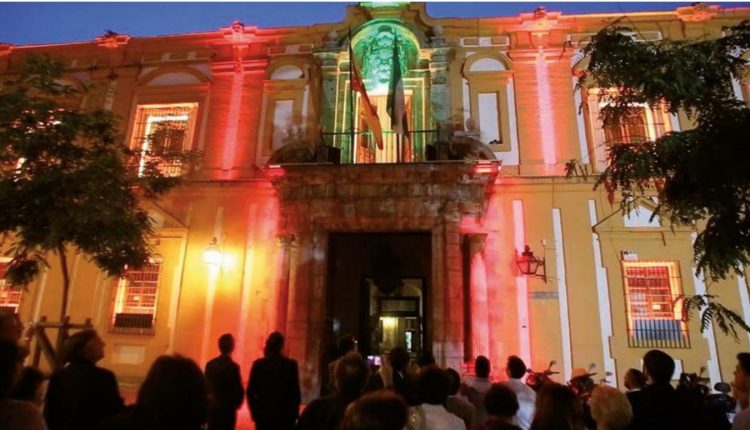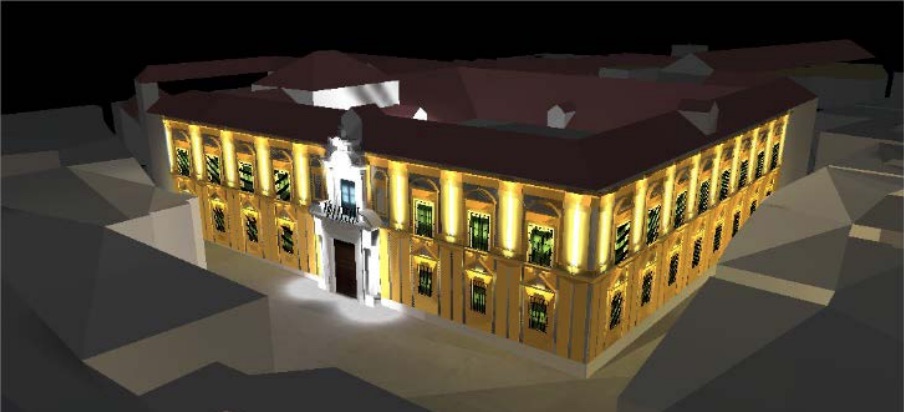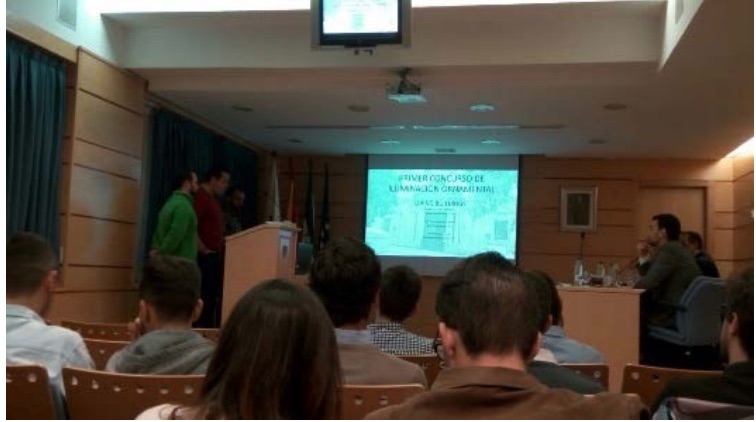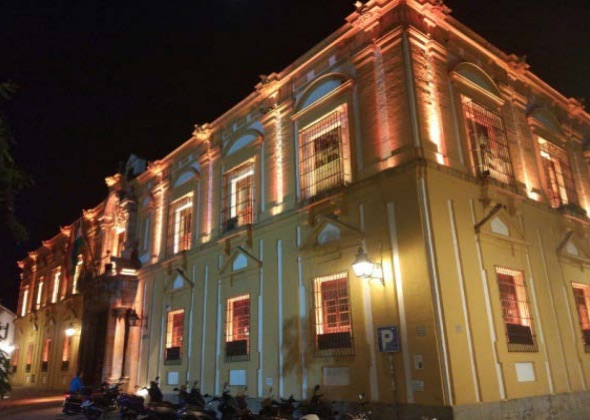
Contest of ornamental and artistic lighting of buildings: a successful case of teaching in Engineering based on projects
Concurso de iluminación ornamental y artística de edificios: caso de éxito de enseñanza en Ingeniería basada en proyectos
Fco. Ramón Lara Raya1, José Zamora Salido2, Juan Cantizani Oliva3, Eduardo Ruiz Vela4, Fco. Javier Jiménez Romero5 and José Ramón González Jiménez6
Abstract
Project-based learning is common in engineering studies. In addition to providing the development of academic competences, it allows to work on other transversal competences, such as social, cultural, and even artistic, which are not very common in engineering subjects. This work presents a successful case in the Higher Polytechnic School of Cordoba, in a contest format, based on the architectural and artistic lighting of buildings.
Keywords: Project-based learning, contest, architectural and artistic lighting, electrical engineering.
Resumen
El aprendizaje basado en proyectos es común en estudios de ingeniería, ya que, además de facilitar el desarrollo de competencias académicas propias de estos estudios, permite trabajar otras de carácter transversal, tanto de signo social, como cultural o incluso artístico, poco habituales en materias propias de ingeniería. Este trabajo expone un caso de éxito en la Escuela Politécnica Superior de Córdoba, en formato de concurso, basado en la iluminación ornamental y artística de edificios.
Palabras clave: Aprendizaje basado en proyectos, concurso, iluminación ornamental y artística, ingeniería eléctrica.
Recibido / received: 20/06/2022. Aceptado / accepted: 06/10/2022.
1-6 Higher Polytechnic School of Cordoba, Department of Electrical and Engineering and Automation.
Autor para correspondencia: Fco. Ramón Lara Raya; e-mail: ramon.lara@uco.es
Introduction and goals
Advances in the field of lighting, as well as the growing interest from public and private entities in its application to cultural heritage lighting to enhance the architectural, artistic and/or historical landmarks in cities have given rise to a new field of professional development. Through an appropriate combination of lighting elements, frequently based on led technology, and a detailed study of the effects of light (e.g., different shapes, intensity and colour, its desired effect and so on) visitors can visually enjoy the heritage from another perspective, during the night hours. This gives to the monumental landmarks a greater prominence compared to the rest of the existing elements in their surroundings.
This specialization in the field of lighting public spaces is normally known as “Ornamental Lighting” and, apart from constituting by itself a line of professional development in a booming sector with a great future perspective, it is a path in which the engineer can explore and develop part of his artistic talent, which is not entirely usual, given the typical or traditional activities of this type of professional.
These works require a detailed study regarding the most appropriate exterior lighting for the intrinsic characteristics of the building or monument, its materials and physiognomy, its historical-artistic peculiarities and those of its surroundings, etc. The purely technical studies to establish the location of the light sources and the necessary control equipment, as well as the wiring and connection, must be developed under the observance of the reversibility criterion, facilitating its disassembly in case of renovation or change of criteria in its utility, avoiding then irreversible modifications.
There is no specific training in this area among the engineering studies taught at the University of Cordoba. For this reason and with the double objective of, on the one hand, opening a new field of professional development for future graduates in Electrical Engineering from the Higher Polytechnic School of Cordoba (hereinafter EPSC) and, on the other hand, stimulating them academically through a methodology based on projects, a contest was proposed to carry out, in which the students could not only acquire the technical knowledge base to undertake the design of this type of installation, but also could develop their artistic and creative potential, carrying out the actual execution of the installation in the case of the winning project.
The present work shows the experience carried out in the EPSC of the University of Cordoba, based on the organization of an Artistic and Ornamental Building Lighting contest, consolidating their knowledge in outdoor lighting installations, stimulating, and combining them with their artistic and aesthetic skills and interesting them in the knowledge of part of the cultural heritage of our environment.

Methodology
The development of the activity was carried out in three phases: learning phase, contest phase and execution phase.
Given that an installation of these characteristics in buildings of a certain size can be expensive, and since it was an academic activity, it was developed within the framework of collaboration that the University of Cordoba maintains with the company Signify©, through a temporary transfer of lighting and control equipment. For the rest of the elements, the University of Cordoba collaborated, with annual calls for teaching innovation projects, as well as with a grant from the Vice-Rectorate for Students, the EPSC and the Department of Electrical Engineering. It was, therefore, a temporary installation, and that entails added complexity to reduce possible traces in the building to be illuminated once all the outdoor equipment had been removed.
The objectives and methodology used in each of these phases are developed below.
Learning phase
The work emphasized on skills related to basic concepts and theory on ornamental lighting, its technical and artistic objectives, as well as the techniques and equipment commonly used. Even beyond the technical requirements, the characteristics of the element to be illuminated, from both the architectural, artistic and heritage point of view were considered as well as the message or perception to obtain from the illuminated element with the chosen design.
To achieve these objectives, a training plan was designed, in which part of the teaching staff of the Electrical Engineering Area of the University of Cordoba participated. Specialists in each of the technical aspects of electrical installations, especially in lighting installations, as well as personnel specialized in lighting outdoor spaces and ornamental lighting from the company Signify©, collaborated in that phase.
Within this training plan, we can highlight the contents related to basic lighting principles, led luminaires, auxiliary equipment and control systems, architectural lighting, beautification of cities (and application areas), design of architectural lighting installations, and DMX control.
This complementary training was given in the format of a university extension course, sponsored by the Institute of Postgraduate Studies of the University of Cordoba. With an extension of 50 teaching hours (2 ECTS credits), the students would be scholarship recipients, in order to encourage their participation. In this sense, it must be said that all the participants in the contest took the course.

Contest phase
During this phase, the bases of the contest were formed, as well as the conditions that the teams that would participate in it should meet. Group members, the type of projects, the amount of the prizes, etc. were also stablished throughout this phase, always advised and under the supervision of the faculty of the electrical engineering area of the University of Cordoba. The developed skills in this phase are related to artistic and creative expression, historical and cultural knowledge, and teamwork.
The contest focused on the presentation and defence of an artistic lighting project on the facade of the building that houses the Faculty of Philosophy and Letters of the University of Cordoba, located in the Plaza del Cardenal Salazar, in the historic centre of Cordoba. This building was designed by the architect Francisco Hurtado Izquierdo (Builder of the Cathedral of Cordoba) in 1704, to be used as a College and Residence for the acolytes and choirboys of said Cathedral. Almost finished, and due to the plague epidemic, that ravaged the city and the scarcity of care centres, it was used as a hospital, giving shelter to poor patients, prisoners, mentally ill patients, etc., and was even used as a military hospital during the Independence War. In 1837, it was used as a hospital for the chronically ill, hence its name as “Acute Hospital”. Between 1871 and 1784 it was the headquarters of the Faculty of Medicine of the University of Cordoba and later it was changing and expanding its dependencies, until it became a University College in 1970. After that it turned into the current Faculty of Philosophy and Letters.
It was decided to fix the positions of the light sources, which would consist of 50 RGB led luminaires located in the spots of greatest architectural interest of the building and those that would allow a greater set of possibilities while performing light shows. The proposals to be made by the participating teams should, therefore, be based on a light and sound show, by means of the choice of a musical theme with which the different installed lights should react to the beat of the music, by changing cadence, colour and intensity, in order to create a show consistent with what the building, its uses and history represent, and at the same time highlighting those architectural aspects considered most noteworthy.
Each team would defend a 3D simulation, with the chosen music, explaining the objective, as well as the technical and artistic criteria on which they based their proposal. Figure 1 shows a snapshot of said simulation, with the location of the 50 luminaires.
The evaluating jury was integrated by the director of the Department of Electrical Engineering, the director of the EPSC, the vice-chancellor of Students of the University of Cordoba, and the person in charge of Marketing of the company Signify©. The assessment criteria would be related to artistic quality, complexity and technical feasibility, coherence and argumentation.
Three economic prizes were established for the three best proposals. In addition, the winning show would be brought to life for two weeks in the building that was the contest scenario.
All the works presented were of exceptional artistic quality and originality, so it was difficult to establish the order of the awards. Finally, nuances of a technical nature decanted the three winning proposals, although it was decided that all of them would be worthy of being brought to reality. The winning proposals were:
1st prize: “The light of history”. It stages the various uses of the building throughout its history, highlighting the first as a residence for the choirboys of the cathedral, then another more sinister and heart breaking as a hospital, and, lastly, another more cheerful and vital as university headquarters. The musical themes that accompanied the show were the B.S.O. “The choir boys” (Bruno Coulais) – “Requiem” (W. A. Mozart) – “La primavera” (A.L. Vivaldi).
1st honourable mention: “Great masquerade ball”. It offers special prominence to the masks that dominate the upper part of the building’s facade. Anthropomorphic figures that provide great uniqueness and architectural value. Musical Theme: “Danse Macabre” (C. Saint-Saëns).
2nd honourable mention: “Flamenco rock in the light”. A nod to the past and the present, to tradition and the avant-garde, through a flamenco-rock fusion musical theme, performed by flamenco and electric guitar. Musical Theme: “Pastosi” (Mike Olfield and Diego Cortés). Figure 2 shows a snapshot of the moment of exposure and defence of the teams.

luminaires used.
Execution phase
In this phase, the actual installation was carried out. Luminaires and control equipment, wiring, protections, sound equipment and audio synchronization with the luminaires were carefully installed. The complexity of this phase is noteworthy, since, as it was an ephemeral action, and a protected building, any permanent modification to its facade or architectural elements had to be avoided. It was necessary then to use fastening elements supported on certain blasting and projections, always avoiding perforations or erosion on the facade. The students actively participated in this phase, in tasks of laying cables, connecting and positioning the luminaires, or directing and programming the shows. With them, skills related to the solution of real problems were worked on, transferring theoretical concepts to practice and teamwork. The final result is shown in figure 3.
Results
The excellent academic results, focused on technical skills and exploring the creative facet of the students, were corroborated by the quality of the final results, both technical and artistic. Proof of this is that the shows lasted more than a month, at the request of the centre that houses the building, generating a large number of visitors who came to see it every night. This generated a great impact and social repercussion, with publications in numerous media, both local and national.
This experience gave rise to a second call in another building, also at the University of Cordoba, which, because of the state of alarm, had to change its deadlines, so the monitoring and results could not be developed with the same continuity. This is not an obstacle to continue working on this type of project in the future, with new proposals and applied technologies.
Conclusions
The benefits that this type of learning methodology generate in the participating students are evident. On the one hand, project-based work encourages participation and teamwork, ensuring that each member can contribute with their vision, as well as their best qualities and characteristics at the disposal of the team. On the other hand, the competition format generates an additional stimulus for a job well done, by rewarding effort and overcoming difficulties, and enabling the inclusion of transversal skills, rarely reflected in engineering study plans, such as those of social, cultural or artistic ones.
Aknowledgments
The experience required a great personal and logistical effort. This could not have been carried out without the contribution of the technical and economic resources of the collaborating entities, such as the University of Cordoba itself, as well as the company Signify©, which participated in all phases of the contest, especially in the execution phase, providing all the technical material necessary to carry out the lighting of the building.
References
Benítez, A. y García, M. L. (2013). Un primer acercamiento al docente frente a una metodología basada en proyectos. Formación universitaria, 6(1), 21-28.
Fernández, F. H., & Duarte, J. E. (2013). El aprendizaje basado en problemas como estrategia para el desarrollo de competencias específicas en estudiantes de Ingeniería. Formación universitaria, 6(5), 29-38.
Millán, M., Avilés, A., González, J., López, J., y Carrillo, S. (2016). Los concursos de arquitectura como herramienta para el aprendizaje cooperativo y colaborativo en el grado de arquitectura. En XIV Jornadas de Redes de Investigación en Docencia Universitaria: Investigación, innovación y enseñanza universitaria: enfoques pluridisciplinares (pp. 369- 382). Instituto de Ciencias de la Educación.
I Concurso de Iluminación Ornamental de edificios públicos, Universidad de Cordoba-Philips Lighting (10 de mayo de 2022). Available at: https://www. youtube.com/watch?v=SKvAEEUtkgg

